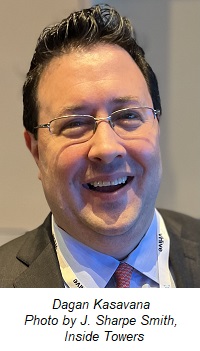TowerXchange Exclusive Coverage
Phoenix Tower International has come out of the COVID-19 pandemic with a lot more towers and more capital. That was the upbeat assessment Dagan Kasavana gave of PTI over the last two years in a fireside chat with Natalia Gorohova, TowerXchange Head of Research – Americas, during last week’s TowerXchange Meetup Americas 2022 in West Palm Beach, FL. The CEO discussed PTI’s journey as it transformed itself through a global tower buying spree.
Earlier this month, PTI acquired up to 3,800 towers from WOM, an MNO in Chile. Before that, it acquired 202 towers in the U.S. from Tower Ventures Holdings III, LLC and over 3,200 towers from Cellnex Telecom in France. Last year, it acquired 830 towers from Monaco Telecom across Malta and Cyprus (plus newly constructed towers for six years in a build-to-suit program) and 203 towers in the French West Indies from Outremer Telecom. In 2020, PTI picked up leasing rights to 2,400 towers in Italy, 600 towers in Ireland, and 4,000 towers in France, as well as nearly 200 more towers in the U.S.
Today, PTI’s portfolio numbers more than 5,000 towers across Europe, which makes it one the largest independent private tower owners in Europe, according to Kasavana.
“We think it’s really important as you drive organic growth across your portfolio, to be independent, to be able to have great conversations with all of the carriers in all of the markets that you’re in and really talk to them about their growth plans, their business plans and how we can provide for them,” he said. “We think that leads to more organic growth in our towers. It’s more of a partnership approach with our customers.”
With the WOM acquisition, PTI becomes a major, independent private player in Latin America with towers in all the major markets, except Brazil, which may be on the menu soon for PTI. What makes Chile attractive to PTI, Kasavana said, is that it is one of the wealthiest markets and healthiest tower markets in Latin America, because it has four well-capitalized players. PTI chose WOM because it already has experience with the MNO, which is building out its network in Colombia. Additionally, WOM is growing fast, according to Kasavana, so PTI wants to be a part of that growth.
“And so we felt like partnering with them in Chile as their industrial partner,” he said. “We think they’re going to enter other markets in Latin America. We think we’re well positioned to continue the dialogue with them and help them achieve their goals.”
Another highlight for PTI came in December of last year when it recapitalized its business through Blackstone Infrastructure Partners, which bought out John Hancock as the 35 percent owner of PTI. “Most of the new capital in the business plan will come from Blackstone’s perpetual fund,” Kasavana said. “What that means is that we’ll be in the tower space for a long time to come.”
In another important event to PTI’s future, it hired Scott Lewis to the new position of vice president of Next Generation Solutions. Lewis will focus on guiding the tower company in business ventures in tangential technologies. Kasavana noted that PTI has invested in infrastructure outside of towers, including data centers, fiber and small cells, but he wanted to be more intentional about it.
“We needed to be smarter to work through which markets we should be investing in technologies outside of towers,” Kasavana said. “We felt like we needed to be doing more strategizing around where we wanted to spend our time and energy. We also felt like the team that’s ultimately going to deploy the networks with regards to next generation solutions has to be bigger and it needed a leader.”
In another venture outside of tower ownership, PTI invested in U.S.-based telecom infrastructure services company, Technology Associates EC Inc., which expanded PTI’s U.S. service offerings, including project management, data management, site acquisition, backhaul and AAV/fiber design and acquisition, architecture and engineering design and structural engineering, and construction project management.
“As we think of the U.S., we are looking at deals outside of towers and the opportunities that will come from the elevated 5G capex spend over the next decade,” Kasavana said. “We felt like investing in a services company to really help our customers in the U.S. was a nice way to grow in a way to draw them closer and become their strategic partners, above and beyond just a traditional towerco model.”
By J. Sharpe Smith, Inside Towers Technology Editor





Reader Interactions